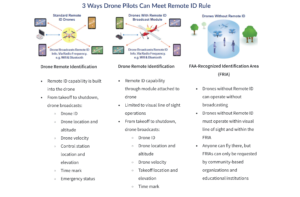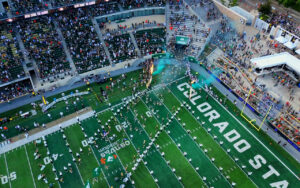Today is July 4th, the day we celebrate the birth of our nation. And every year, more and more people fly their drones to get video and stills of local fireworks displays. Which inevitably leads to questions about the rules to fly at night. Which inevitably leads to scores and scores of wrong (but usually well-meaning) answers. Those answers run the gamut of “you need a night waiver” to “there are no rules at all”. So much confusion.
Someone suggested I write an article summarizing these questions, finally putting all of the answers in one place. Because there are two different set of rules to fly under in the U.S, and they aren’t in the same place.
So here it is, the definitive answer to this question, whether recreational (49 USC §44809) or non-recreational (14 CFR §107).
Recreational.
Yes, as a recreational flyer, you can fly at night. And yes, there are rules.
Requirements are strobes (lighting) showing attitude (orientation) and altitude. This is from 49 USC §44809 (2). That requires you to fly under an FAA approved CBO. However, those haven’t been developed yet. So the FAA has us default to the older rules under 336 in the meantime.
The FAA says to follow a current CBO in section 7.1.2 of AC 91-57B. Most people use AMA’s safety guidelines which state, “Night flying requires a lighting system that provides the pilot with a clear view of the model’s attitude and orientation at all times.” That is where the “attitude and altitude” language comes from. Until the FAA publishes the actual CBO list, this is the best to use. No, you don’t have to use the AMA’s but they are a good source. Nor do you have to be a member of the AMA to use them. Most, if not all, ready to fly (RTF) drones built by the major manufacturers have OEM lighting that will satisfy this requirement.
Also, unlike commercial flights, recreational night flights may not take place in controlled airspace. You can only fly in Class G airspace. Make sure you check your airspace before flying at night. The FAA’s UAS Data Map is perfect to double check what airspace you’re in. Put the address of where you’re flying in the search box.
You also must take TRUST. But that’s not tied to night flights, that is tied to the latest rules update for recreational flyers put out by the FAA. We at DSPA recommend you take TRUST at Pilot Institute.
Many believe that the 3 Statue Mile strobes are also required for recreational night flight. They aren’t. But we at DSPA strongly encourage night flyers to be as safe as possible. As such, it’s worth the extra expense (as low as $30) to add those strobes to your drones anyway. And it’s never a bad idea to have more training. The Pilot Institute comes through here as well. They’ve put together a great course on flying drones at night, and offer it for free. Their course is geared towards 107 Pilots, so not all of the information is relevant to recreational flyers, but the safety aspects are. Check out Greg’s offering, as mentioned it’s 100% free.
Remember, safety first, and last, and always.
Also, once the FAA publishes the list of CBOs with a “set of safety guidelines that are developed in coordination with the Federal Aviation Administration”, the night flight requirements for recreational night flights may change. We’ll update this page when that happens.
Commercial (non-recreational).
You, can fly at night as well, with a few caveats.. Actually only two caveats. 107 night flights are actually much more cut and dried, with zero ambiguity or nuance.
As mentioned, there are only two requirements when flying UAS at night under the 107 umbrella. First, according to 107.29 (b) you must have strobes visible from 3 statute miles (3SM). Second, must also have taken your initial Remote Pilot Test or Recurrent Training on or after 4/6/21.
That’s it, satisfy those two criteria and you’re good to fly your drone at night with your Remote Pilot Certificate. But just like recreational night flights, there is the legal way to fly, and the safe way to fly. DSPA strongly recommends additional training for the sake of safety. Use the Pilot Institute link above to take advantage of their generous free contribution for keeping the NAS safe.
Also, on a side note, if you have a Daylight Waiver those are no longer valid. You can no longer use it to satisfy all aspects of 107.29. As per changes in the 107.29 language under the Operations Over People Final Rule, the FAA terminated all of those an 5/17/21.
Contrary to what some say online, there are no FAA certified 3SM strobes. It is up to each remote pilot to determine if it qualifies, and the manufacturer is allowed to say they’ve tested them. Pretty much any drone strobe from Lume Cube or Firehouse Technologies satisfies that criteria.
Finally, if you want to fly at night in controlled airspace, you must have a LAANC approval for the date you want to fly, or a COA for that airspace. In either case, print out FAA Form 7711-1, and carry it with you. LAANC should be capable of approval for non-daylight hour flights in late 2021. 7711-1 expires on 9/30/21. So that would the target date for LAANC/107.29 implementation. And odds are once LAANC and night ops start being compatible, all of us who hold wide area or site specific long term COAs will have to use LAANC. The only exception would likely be long term COAs outside UASFM maximums.
We hope this clarifies things. If not, feel free to reach out.


